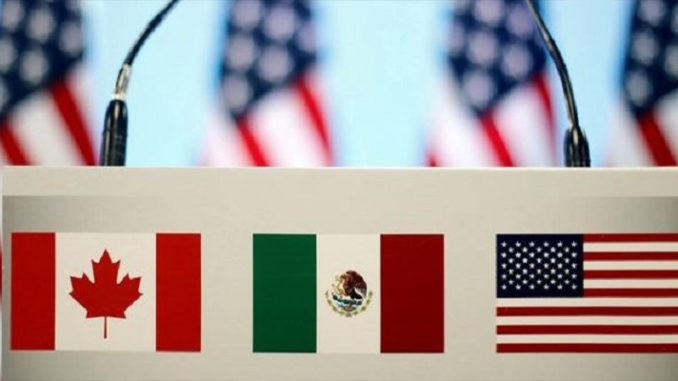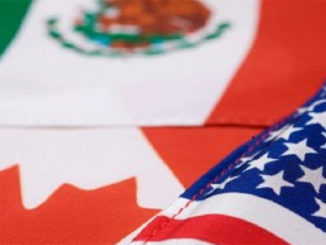
Canada has yet to agree to the Trump administration’s latest NAFTA proposal. And perhaps for good reason. That proposal, based on a bilateral deal struck between the United States and Mexico, already faces heavy criticism. Analysts point out that if we “peer under the hood,” the deal doesn’t improve much on NAFTA. The U.S. gets less than it would have under the original TPP. Meanwhile, Canada would have to agree to weakened enforcement provisions.
Now that Trump has formally notified Congress of his intentions to sign the U.S.-Mexico deal, it’s worth asking: Is the agreement any good? To answer that question, we need to consider the purpose of having trade agreements in the first place.
A common assumption is that trade agreements are mainly about promoting new trade. But tariff cuts are just one part of a much larger story.
The underappreciated value of trade agreements is that they stabilize trade relations. Deals like NAFTA provide a rules-based system that, as leading trade law expert Simon Lester puts it, “provide mutually agreed constraints on protectionism.”
These “constraints” mean that member states are limited in their policy choices. Governments can’t simply do whatever they want to protect the domestic market. Rather, barriers to trade are permitted only under circumstances specified in the deal.
These rules are not just some obscure detail of international trade law. They are in place to protect the health of the global economy.
The danger is this: Ad hoc, unregulated protection creates volatility in the marketplace. That’s precisely what we’re seeing now with fluctuations in the flows — and in the prices — of steel, washing machines, and solar panels, all of which were targeted by White House tariffs in 2018.
Given these very real consequences, reducing uncertainty in the marketplace is in countries’ shared interests. That’s the often overlooked value of trade law: It tells countries how to trade, not just how much to trade.
So how does the U.S.-Mexico fare on this front?
In some respects, the new deal claims to strengthen some of NAFTA’s original agreements. Back in 1994, NAFTA was uniquely ambitious in its rules relating to labor and the environment. This week, the Office of the United States Trade Representative (USTR) announced that provisions have been deepened in both areas.
Most of the attention has been paid to the rules of origin provisions. “Rules of origin” refer to the “criteria needed to determine the national source of a product.” This may sound like another highly technical matter of trade law, but it’s important.
Under the original NAFTA deal, many goods determined to be made in North America enjoy zero tariffs. However, determining where a good is made is not always straightforward. The products we purchase are composed of parts and materials sourced from a wide variety of foreign markets. All of these rules (which also touch on many other areas) are useful for regulating trade relations among countries.
Unfortunately, other aspects of the new deal are less helpful. This is because the deal achieves one of the Trump administration’s original goals: weakening NAFTA’s dispute provisions.
NAFTA contains several chapters that outline the conditions under which Canada, Mexico, and the U.S. can sue each other for discriminatory trade practices. One of these is Chapter 19, which allows countries to challenge uses of anti-dumping — one of the more common ways by which countries protect themselves from cheap foreign goods. Not coincidentally, the United States is a world leader in anti-dumping use.
Dispute settlement provisions like Chapter 19 are important. They are the best tool that trade agreements have to enforce the law. If they work according to plan, countries incur costs from being sued. These costs should deter future violations of the rules, making participants in the deal better off.
All sides recognize that Chapter 19 could benefit from reform. But simply removing it yanks out a few of NAFTA’s legal teeth.
That’s bad news for the stability of the North American market. Scrapping dispute settlement provisions opens the door for exactly the kind of trade protection that generates uncertainty. That’s a big reason why Canada has insisted on keeping that chapter.
Eliminating Chapter 19 certainly doesn’t mean the end of dispute settlement. Members could still direct complaints to the WTO’s dispute system. The trouble is that the Trump administration continues to cast doubt on the WTO’s legal authority, recently threatening to withdraw over America’s track record of losing disputes. That system now faces gridlock as the U.S. continues to veto the reappointment of Appellate Body members.
There’s also the United States Court of International Trade. CIT is a little-known but highly active forum for settling trade-related disagreements. However, Canada has yet to be convinced that CIT is a viable alternative.
Thus, these other avenues look unsatisfying. That’s why there’s a value in having dispute provisions in the deal.
Now Canada has to decide whether to accept Trump’s terms under mounting pressure. Prime Minister Trudeau previously expressed unwillingness to compromise on dispute settlement, although he has recently signaled a desire to reach an agreement with the U.S.
Ultimately, having some deal might be better than having nothing. The renegotiation process has already generated tremendous uncertainty. And such uncertainty isn’t sustainable.
Jeffrey Kucik is an Assistant Professor in the School of Government and Public Policy at the University of Arizona. He is the author of the trade analysis site www.trademonitoronline.com.



